- Joined
- Feb 28, 2002
- Messages
- 7,636
I first went through the "double-edged boot dagger" phase in college, when the Gerber Mark 1 and inexpensive copies of it were the only knives I would buy. I amassed quite a few of them before I got over them. I even managed to stab myself in the arm, once, with a Mark 1 copy. There's a certain Zen clarity that goes with the thought, "Should I leave the knife in my arm, or pull it out?"
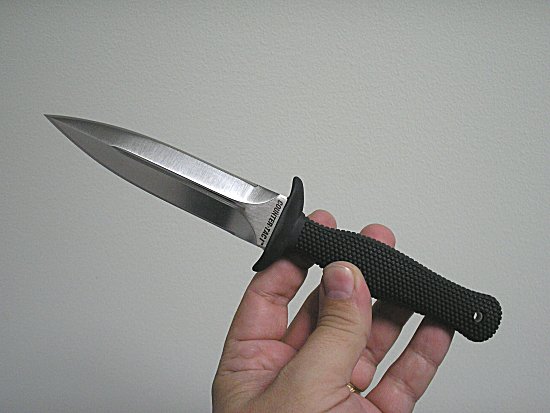
I have a small white scar in the shape of the diamond-cross section of the tip of that double-edged knife to this day. A decade and a half later, I'm not obsessed with the design as I was then, but I still appreciate a good double-edged blade. That brings us to the latest incarnation of what could be considered the "Gerber Mark 1 Genre" -- that is, any knife with two edges and a tapered spear-point tip. The sample that most recently crossed my desk was the Cold Steel Counter Tac 1.
At first glance the Counter Tac 1 is almost sexy in its classic lines and centered groove (I guess you could consider it a "blood groove" if that turns you on).

The edges are hollow-ground and taper to a needle point. The knife shipped as scary-sharp as I expect from Cold Steel, capable of popping hair off my arm and slicing effortlessly through the edge of a sheet of paper. On a trip to the dumpsters behind my office, the knife also penetrated stacked cardboard and heavy plastic barrels very well, thanks in part to the full-sized handle that affords plenty of leverage.
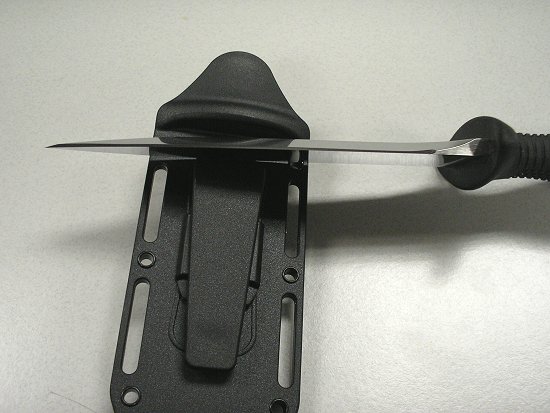
When you turn the knife over, however, you realize just why the knife tends to veer off at a specific angle when cutting through anything extensive. This is because it's deeply hollow-ground on one side only. The opposite side is completely flat. While this makes the knife cheaper to manufacture and easier to sharpen (the most compelling reason for any chisel-ground edge on a knife, especially folders), I felt almost ripped off. No part of the original website description indicated that this was the case.
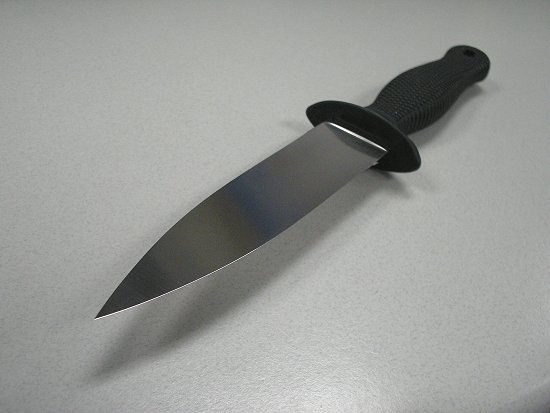
"Hollow ground," to me, implies hollow-ground edges on both sides that meet in the middle at a very sharp point. While I can't fault the sharpness of the blade, the edge geometry really left me cold. Being sharpened on one side only -- and being deeply contoured on that sharpened side -- means the Counter Tac 1 just doesn't handle the way it should.
When it cuts even moderately heavy material (like cardboard) you can feel the difference as the thick blade, tapering to its single sharp side, drags the edge to one side, like a car with a bad wheel alignment. This doesn't change the mechanics of a thrust, nor should it really make a difference when slashing a human being in a defensive encounter, but the difference between the look of the knife from its sharpened side and the performance of the knife in actual handling really drives me nuts.

The full-tang, five-inch blade of AUS 8A steel ("vacuum heat treated and sub zero quenched for strength," if you care) is attached to a Kraton® handle four and a half inches long. The handle swells to fill the palm and is grooved and stippled to afford excellent traction. The integral double guard is more than ample to protect the hand from sliding onto the blade.
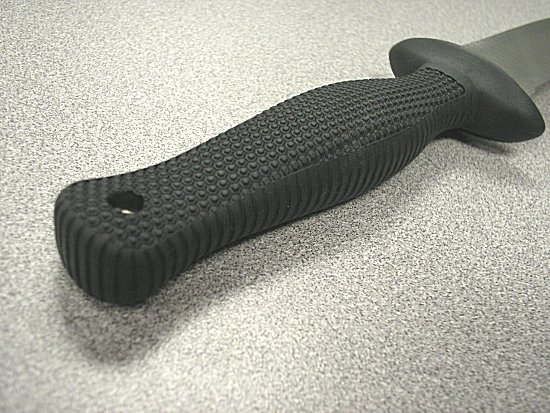
The guard is also the means of securing the knife in the included Secure-Ex® sheath, as it forms a friction-fit with the mouth of the sheath. Repeated use ought to loosen this fit, but out of the box the knife is extremely hard to remove from the Secure-Ex® sheath. The sheath has holes and mounting slots to which one might attach straps or other hardware. The plastic boot-belt clip is removable but attaches quite securely and shouldn't work its way loose unintentionally (a common problem with removable clips).
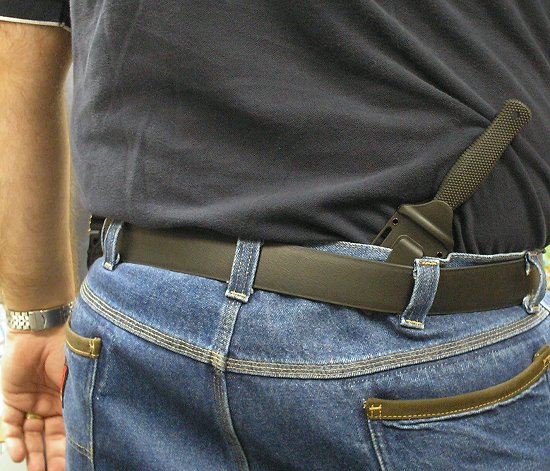
The Counter Tac 1 is an adequate dagger that could have been a great knife. On paper, it has all the features you'd want in such a knife, despite the tight sheath fit. In reality, the lopsided blade geometry married to 5mm stock is frustrating and less than elegant, effectively undercutting the inherently clean design that embodies any simple, double-edged blade.
It's not a bad knife, but it could have been so much better.

I have a small white scar in the shape of the diamond-cross section of the tip of that double-edged knife to this day. A decade and a half later, I'm not obsessed with the design as I was then, but I still appreciate a good double-edged blade. That brings us to the latest incarnation of what could be considered the "Gerber Mark 1 Genre" -- that is, any knife with two edges and a tapered spear-point tip. The sample that most recently crossed my desk was the Cold Steel Counter Tac 1.
At first glance the Counter Tac 1 is almost sexy in its classic lines and centered groove (I guess you could consider it a "blood groove" if that turns you on).

The edges are hollow-ground and taper to a needle point. The knife shipped as scary-sharp as I expect from Cold Steel, capable of popping hair off my arm and slicing effortlessly through the edge of a sheet of paper. On a trip to the dumpsters behind my office, the knife also penetrated stacked cardboard and heavy plastic barrels very well, thanks in part to the full-sized handle that affords plenty of leverage.

When you turn the knife over, however, you realize just why the knife tends to veer off at a specific angle when cutting through anything extensive. This is because it's deeply hollow-ground on one side only. The opposite side is completely flat. While this makes the knife cheaper to manufacture and easier to sharpen (the most compelling reason for any chisel-ground edge on a knife, especially folders), I felt almost ripped off. No part of the original website description indicated that this was the case.

"Hollow ground," to me, implies hollow-ground edges on both sides that meet in the middle at a very sharp point. While I can't fault the sharpness of the blade, the edge geometry really left me cold. Being sharpened on one side only -- and being deeply contoured on that sharpened side -- means the Counter Tac 1 just doesn't handle the way it should.
When it cuts even moderately heavy material (like cardboard) you can feel the difference as the thick blade, tapering to its single sharp side, drags the edge to one side, like a car with a bad wheel alignment. This doesn't change the mechanics of a thrust, nor should it really make a difference when slashing a human being in a defensive encounter, but the difference between the look of the knife from its sharpened side and the performance of the knife in actual handling really drives me nuts.

The full-tang, five-inch blade of AUS 8A steel ("vacuum heat treated and sub zero quenched for strength," if you care) is attached to a Kraton® handle four and a half inches long. The handle swells to fill the palm and is grooved and stippled to afford excellent traction. The integral double guard is more than ample to protect the hand from sliding onto the blade.

The guard is also the means of securing the knife in the included Secure-Ex® sheath, as it forms a friction-fit with the mouth of the sheath. Repeated use ought to loosen this fit, but out of the box the knife is extremely hard to remove from the Secure-Ex® sheath. The sheath has holes and mounting slots to which one might attach straps or other hardware. The plastic boot-belt clip is removable but attaches quite securely and shouldn't work its way loose unintentionally (a common problem with removable clips).

The Counter Tac 1 is an adequate dagger that could have been a great knife. On paper, it has all the features you'd want in such a knife, despite the tight sheath fit. In reality, the lopsided blade geometry married to 5mm stock is frustrating and less than elegant, effectively undercutting the inherently clean design that embodies any simple, double-edged blade.
It's not a bad knife, but it could have been so much better.
